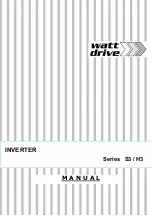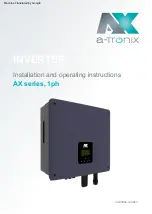
SECTION 8 |
Installation
37
2. To prevent possibility of paralleling and severe damage to the inverter,
never use a simple jumper cable with a male plug on both ends to
connect the AC output of the inverter to a handy wall receptacle in the
home / RV.
8.5.1 AC Output Connection wiring
For connecting the AC output of the inverter to an AC Panelboard / Load Center,
separate connections are available for hard wiring. Please refer to fig 6.1.
Compartment (11, fig 6.1b) contains terminals for AC output. The compartment is
covered by Cover Plate (8, fig. 6.1a) with the help of 4 screws. The AC wiring enters
through the metal Strain Relief Clamp (7, fig. 6.1a). After the connections have been
made, tighten the clamp. AC output connections are as follows:
Terminal Block (13, fig. 6.1b) with Line “L” and Neutral “N” Terminals.
Please note that Line terminal “L” of the AC Terminal Block (13, fig 6.1b) is internally
connected together at the PCB. Similarly, Neutral terminal “N” on the AC Terminal
Block (13, fig. 6.1b) internally connected together at the PCB.
• Hole diameter: 4. 15 mm / 0.16”
• Set screw: #6 (UNf, 40 threads per inch) or M3.5 ( Coarse Pitch 0.6 mm)
AC Ground Terminal (12, Fig 6.1b)
• Stud: #6 (UNC, 32 threads per inch)
Neutral to Chassis Ground Bonding
• Neutral “N” is bonded to the metal chassis of the inverter through a loop of wire
connecting the “N” terminal on the Line side.
TABLE 8.4 RECOMMENDED SIZING OF AC OUTPUT WIRING AND BREAKER
Model No.
(1)
Maximum
continuous AC
output current
(2)
Minimum
Ampacity of
AC output Line
and Neutral
conductors as
per NEC (125%
times Column 2)
(3)
Maximum size
of external AC
output Breaker
(based on
column 3)
(4)
Minimum size of
Line and Neutral
conductors based
on Ampacity
at Column 3
(Ampacity based
on conductor
temperature of
90°C)
(5)
SWI 3000-12/
SWI 3000-24
13A
16.25
16A
2.5 mm
2















































